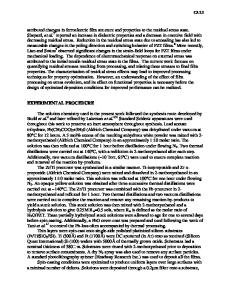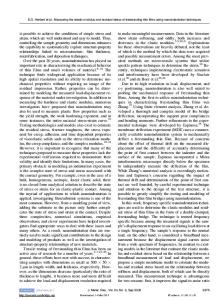Measuring Residual Stress Effects of Acceptor Doping In Tunable Microwave Dielectric Thin Films
- PDF / 114,231 Bytes
- 6 Pages / 612 x 792 pts (letter) Page_size
- 66 Downloads / 349 Views
C8.1.1
Measuring Residual Stress Effects of Acceptor Doping In Tunable Microwave Dielectric Thin Films
W. D. Nothwang, M. W. Cole, C. Hubbard, and E. Ngo U.S. Army Research Laboratory APG, MD 21005 There has been a recent shift towards a tunable phase shifter for microwave antenna design. Barium strontium titanate [BaxSr(1-x)TiO3] thin films are the principal materials of interest in these applications, primarily because of their low loss, high dielectric constant and large tunability. Both magnesium doped and undoped films were made, and they were deposited on MgO or Pt-Si substrates using metal organic solution deposition and pulsed laser deposition. Residual stress within these materials is known to have a drastic effect on the material, electrical, and dielectric properties. This becomes of particular importance in thin film materials, where the residual stress can be several orders of magnitude higher than in bulk materials. The residual stress in the films was measured in three ways. A Tencor stress analysis system was employed to measure the change in the substrate curvature due to the film stress, and a nano-indentation method was used to calculate the residual stress in a system by measuring the maximum penetration, the force at maximum penetration, and the slope of the initial unloading curve. These methods were validated using XRD lattice calculations. Stresses as high as 2 GPa were observed under certain conditions. The results also show that the surface region of the films is not stress free at these thicknesses (~200 nm) as was mathematically suggested. INTRODUCTION Tunable dielectrics are becoming increasingly more important for a variety of frequency agile RF and microwave applications, including tunable filters, varactors, voltage controlled oscillators, and delay lines. Several strategies have been used to improve the dielectric properties of RF thin films. The nature of the film’s material properties, such as, surface morphology, structure, microstructure, composition, film-electrode interface, texture and residual stress have been identified as the primary factors affecting device performance. Specifically, film stress has been shown to have a dominant influence on the films material properties.1 Recent studies on the effects of residual stress on dielectric thin film properties have shown that the mechanical lifetime of multilayer integrated structures on silicon substrates decreases with increasing stress levels and the crack propagation rate increased with increasing stress levels2-4. Others have shown that residual stress, associated with thin film heterostructures, caused the phase and Curie transitions to be significantly broadened as compared to their bulk counterparts, resulting in enhanced temperature stability.5-7 It has also been shown that residual stress is responsible for inducing ferroelectricity in a paraelectric material.8 The converse is true as well, as high residual stresses will diminish the permittivity of a material. Shaw et al. observed that a high residual stresses will
Data Loading...










